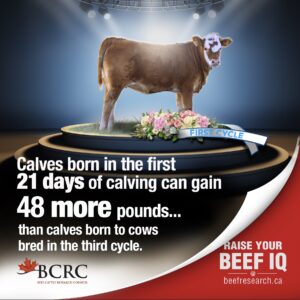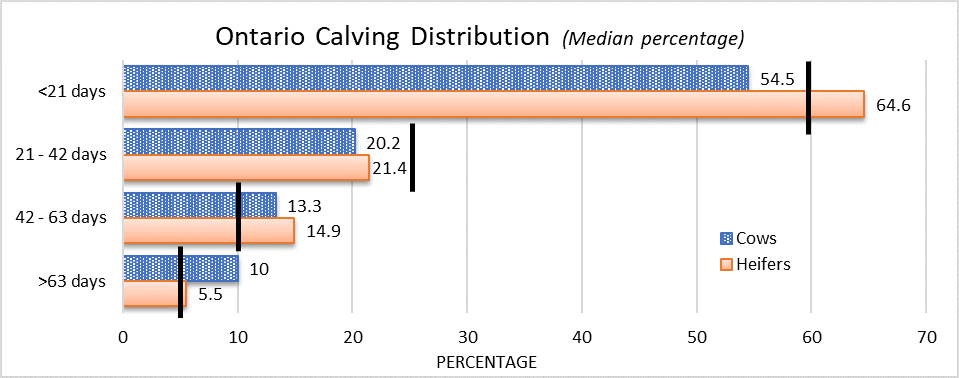A Prolonged Calving Season can be Costly: New Calculator Available
Remarque : cette page web n’est actuellement disponible qu’en anglais.
As the calving season ends and producers switch gears toward breeding season, there is an opportunity for producers to evaluate their calving distribution and the impact it has on their bottom line. Now is the time for farmers and ranchers to incorporate any changes they want during breeding season, such as when to pull their bulls from pasture, that will affect next year’s calf crop.
Calving distribution is the percentage of calves born in each 21-day cycle throughout the calving season.

Each time a cow is not bred during a 21-day heat cycle, it can cost up to 39 lbs of weaning weight (assuming an average daily gain on calves of 1.85 lbs/day). Having more calves born in the first 21 days of the calving season allows producers to market larger, more uniform groups of calves and increase their profit potential.
The standard industry target is to have at least 60% of females calving within the first cycle, followed by 25% calving between 21-42 days, 10% between 42-63 days and the remaining 5% calving in the fourth and final cycle. An ideal distribution could be 70-20-10 with a condensed breeding season of three cycles (63 days).
How does the industry target compare to actual calving distributions on farms across the country? The 2015/16 Ontario Cow-Calf Production Survey, for example, showed on average 5-10% of all females calved after 63 days or three cycles. The 2013/14 Western Canadian Cow-Calf Survey reported similar numbers with a calving distribution of 55-30-10-5. Recent data on calving distributions in Atlantic Canada is unavailable.
To see what your current calving distribution is, and what the impact on your revenue would be if you move to the industry target of 60-25-10-5, or a condensed breeding season of three cycles (63 days) at 70-20-10, check out the new “Value of Calving Distribution” Tool. As with all decision-making tools, you must consider the balance between any increased revenue with the cost of achieving that outcome.
Heavier weaning weights are the most immediate benefit from more calves born in the first cycle, however having more cows bred early can also affect cow longevity. Research from the Western Beef Development Centre found that over 16 years, from 2001 to 2017, heifers that calved earlier had greater pregnancy rates, remained in the herd longer and produced one more calf in their lifetime than those that calved in the later periods (Daalkhaijav et al 2018). Heifers calving in the first 21-day cycle produced 18.2% and 27.3% more pounds at weaning, generating an additional $773 to $1160 in calf revenues over their lifetime. According to Alberta Agriculture and Forestry it cost $962 per cow wintered in 2016; therefore, a heifer would need to wean five consecutive calves to cover her development costs. In the WBDC study only the heifers the calved in the first 21-day cycle met this threshold (Daalkhaijav et al 2018).
For producers to see an improvement in their calving distribution next year, they need to understand the factors at play in their existing scenario and determine if and how they will adjust their breeding season decisions now.
Try the Calculator
- References
- Fine-Tune Your Breeding for Extra Money https://www.gov.mb.ca/agriculture/livestock/beef/print,fine-tune-your-breeding-for-extra-money.html
- R. A. Cushman, L. K. Kill, R. N. Funston, E. M. Mousel, and G. A. Perry. Heifer calving date positively influences calf weaning weights through six parturitions. J. Anim. Sci. 2013.91:4486–4491. doi:10.2527/jas2013-6465
- Daalkhaijav Damiran, Kathy Larson, LeahPearce, Nathan Erickson & H.A.(Bart) Lardner. 2018. Effects of Heifer Calving Date on Longevity and Lifetime Productivity in Western Canada. Sustainable Agriculture Research; Vol. 7, No. 4 https://doi.org/10.5539/sar.v7n4p11
- R. N. Funston, J. A. Musgrave, T. L. Meyer, and D. M. Larson. 2012. Effect of calving distribution on beef cattle progeny performance. J. Anim. Sci. 2012.90:5118–5121. doi:10.2527/jas2012-5263
- Mousel, E. M., Cushman, R. A., Perry, G. A., & Kill, L. K. (2012). Effect of heifer calving date on longevity and lifetime productivity. Available: http://www.appliedreprostrategies.com/pdfs/2012ARSBC_04MouselProceedings.pdf, accessed May 30, 2019
Click here to subscribe to the BCRC Blog and receive email notifications when new content is posted.
The sharing or reprinting of BCRC Blog articles is welcome and encouraged. Please provide acknowledgement to the Beef Cattle Research Council, list the website address, www.BeefResearch.ca, and let us know you chose to share the article by emailing us at info@beefresearch.ca.
We welcome your questions, comments and suggestions. Contact us directly or generate public discussion by posting your thoughts below.